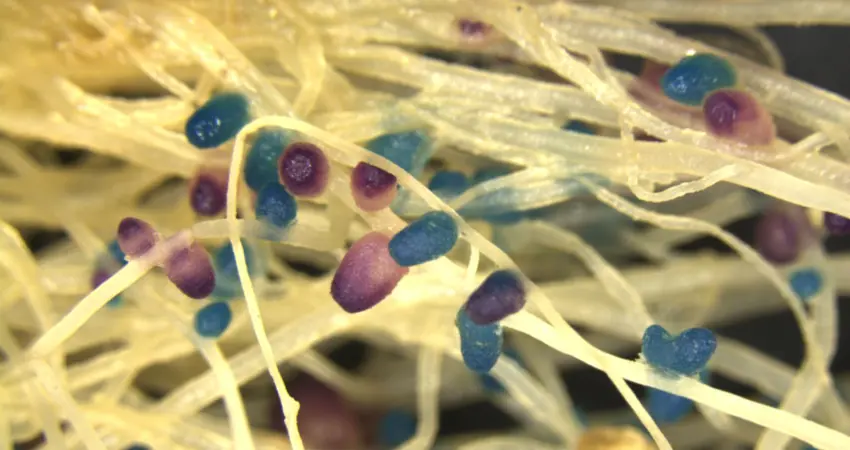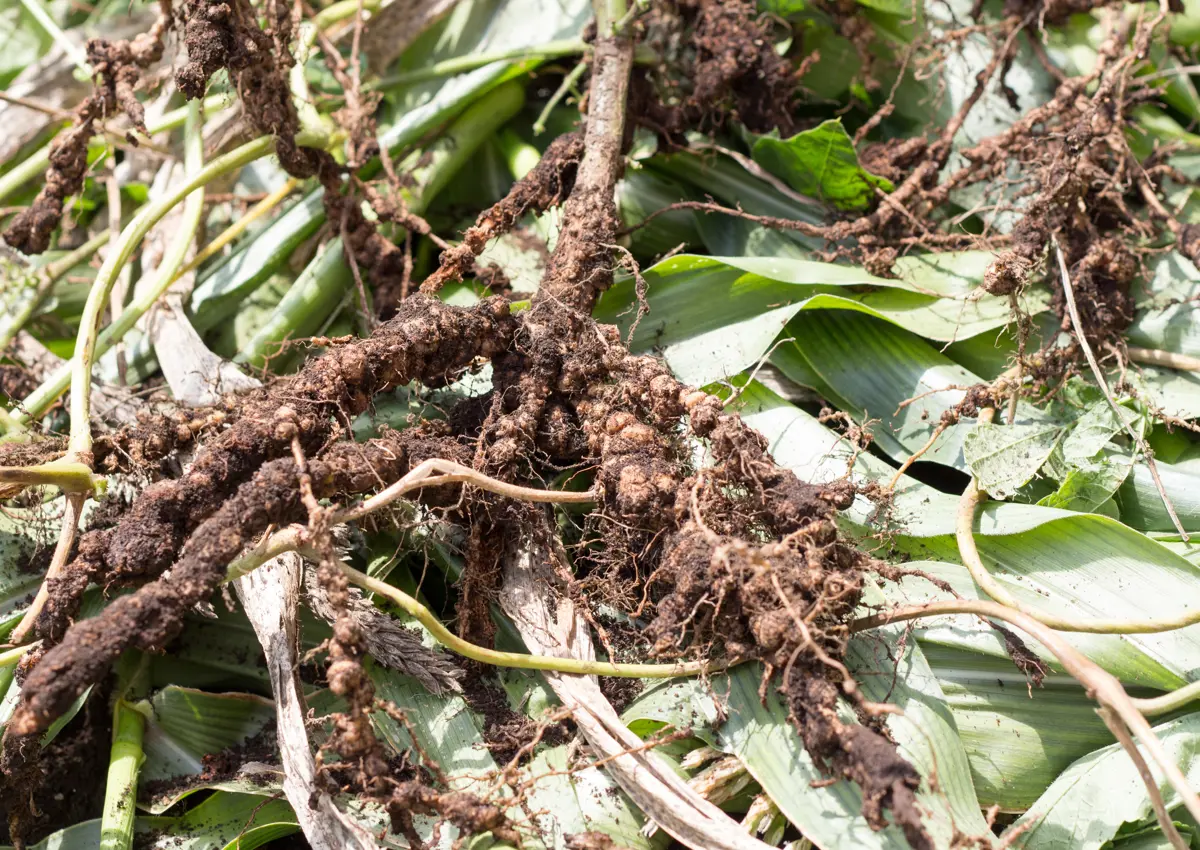16 Aug 2021
Investigating sustainable alternatives to nitrogen fertilizers
Department’s Control Group use metabolic modelling approaches to explain the cellular processes underlying nitrogen fixation

Plant root with stained nodules, courtesy of Raphael Ledermann, Department of Plant Sciences
Nitrogen is one of the main limiting nutrients in agriculture since atmospheric nitrogen gas is not available to plants. Nitrogen fertilizers have therefore been extensively used since the early 20th century, which has drastically increased crop yields, but also caused a plethora of environmental problems.
The Control Group in the Department of Engineering Science is investigating ways to optimise sustainable alternatives to synthetic fertilizers. Certain legume plants (e.g. peas, beans, lentils) form symbiotic relationships with soil bacteria called rhizobia. Rhizobia induce the formation of nodules on plant roots and can “fix” atmospheric nitrogen into compounds that are available to plants. The plant can then use the fixed nitrogen to make proteins, which are an essential part of the human diet and animal feed.
"Biological nitrogen fixation by rhizobia is incredibly important to sustainably address the global challenge of food security"
Carolin Schulte, an Engineering Science DPhil student working with Professor Antonis Papachristodoulou and Professor Philip Poole (Department of Plant Sciences), explains what the groups are doing in this area.
“Biological nitrogen fixation by rhizobia is incredibly important to sustainably address the global challenge of food security, which is why the Poole Lab has been studying rhizobium-legume interactions for many years. We need to understand the metabolic processes underlying nitrogen fixation if we want to make it more efficient. However, once rhizobia are inside the plant nodule and start to fix nitrogen, it becomes very difficult to determine by experimentation what is happening inside the bacteria.
In our recent paper, we used computational approaches to shed light on the nutrient exchanges between plants and rhizobia during nitrogen fixation. We analysed various experimental datasets to compile a list of reactions that are likely to be active in nitrogen-fixing rhizobia. We then used a novel software to look at the nutrients that rhizobia take up and how much nitrogen they provide to the plant in return.
"This study was a great collaborative effort bringing together the previous work of several DPhil students to create a comprehensive picture of rhizobial metabolism during nitrogen fixation"
Plants can regulate how much carbon and oxygen is available to rhizobia and therefore have a lot of control in this interaction – in fact, we know that plants will reduce carbon and oxygen supply if the bacteria are not fixing enough nitrogen. Our analysis enabled us to investigate the various metabolic processes happening inside rhizobia during nitrogen fixation, especially the carefully balanced interplay between carbon and oxygen uptake on the one hand and nitrogen supply to the plant on the other hand. Perhaps the most important finding was that control of oxygen levels by the plant could be an important factor in forcing rhizobia to secrete the nitrogen they fix rather than using it for their own benefit – this is crucial to maintain a productive symbiotic relationship and is an exciting illustration of the exquisite control that plants can exercise over their bacterial symbionts.
This study was a great collaborative effort bringing together the previous work of several DPhil students to create a comprehensive picture of rhizobial metabolism during nitrogen fixation. I was also very fortunate to visit a research group at VU Amsterdam, where the software we used was developed, which was really helpful to expand on the modelling work I had been doing during my DPhil.
"We are planning to use the insights from this work to develop rhizobial strains that fix nitrogen more efficiently than the strains that are currently available"
We are planning to use the insights from this work to develop rhizobial strains that fix nitrogen more efficiently than the strains that are currently available. Various ongoing research initiatives are directed at sustainably improving crop yields to meet increasing global food demands, and optimizing rhizobia to fix the maximum possible amount of nitrogen would be a major step forward in addressing this challenge.“
This work is part of the Control Group's Biotechnology research area. Biotechnology is a rapidly growing area of control inquiry – analysing and designing synthetic biological control systems and developing new hardware platforms to enable experimental studies.

Carolin Schulte, Engineering Science DPhil student

Root nodules containing Rhizobiaceae bacteria (AdobeStock image)




